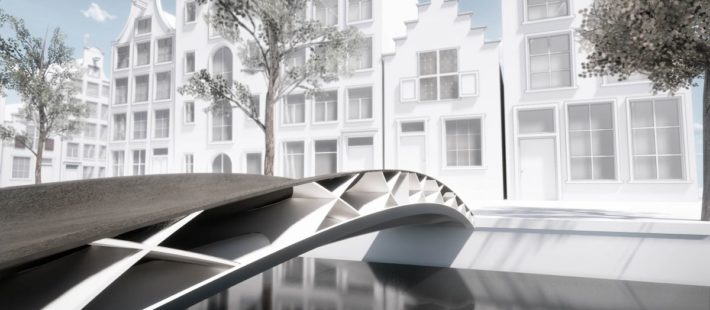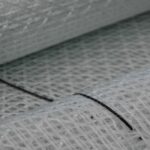The composite material used for the 3D printed bridge consists of a glass filled thermoplastic PET (Arnite) and is combined with continuous glass fibres which are added in the 3D printing process. This unique combination offers high strength with extreme versatility and sustainability.
Royal HaskoningDHV, an international engineering and project management consultancy, worked in partnership with DSM, a global science-based company in nutrition, health and sustainable living and pioneer in 3D printing materials, and CEAD, supplier of 3D printing equipment on the frontier of large scale composite additive manufacturing, to build the 3D printed bridge. Together, the three companies are leading a revolution in bridge construction and design.
Maurice Kardas, Business Development Manager at Royal HaskoningDHV commented, “This partnership is bringing about a paradigm shift in the way we think about the form and function of bridges in our society. FRP bridges are already well known for having a longer lifetime expectancy with lower life cycle costs compared to steel bridges. What’s new here is the use of a new 3D printing technology, enabling us to print large scale continuous fibre reinforced thermoplastic parts. Using this new composite thermoplastic material, we will be ushering in a new era for sustainability and push the boundaries of bridge functionality even further. By including sensors in the design, we can build a digital twin of the bridge. These sensors can predict and optimise maintenance, ensure safety and extend the life span of our bridges. It can also incorporate new functionalities such as monitoring vital environmental aspects and improve the decision-making process for maintenance and inspection via dynamic real-time reports on the condition of the bridge. In collaboration with these industry leaders, we are transforming the traditional playbook when it comes to bridge design and construction.”
The combination of the companies’ generative design and predictive modelling expertise broadens the design freedom. It also allows for a more efficient bridge design as it uses only the precise amount of material required, thus helping to deliver an optimised printing process which results in improved mechanical performance.
Patrick Duis, Segment Leader Additive Manufacturing at DSMadded, explained: “Using a material such as Arnite has huge benefits for the construction of bridges. Rather than using traditional materials such as steel or concrete, these bridges can be much more sustainable and offer greater flexibility in design using recyclable materials. We know that designs previously deemed challenging or impossible to produce with other manufacturing methods are now possible with 3D printing, and we’re excited to be playing our part in this partnership.”
Maarten Logtenberg, CEO of CEAD concluded, “3D printing has evolved dramatically over the years. This 3D printed bridge prototype demonstrates the huge strides that we are making which will transform the future of this industry, not only speeding up construction, but also making the process more cost and time efficient. We developed this technology for exactly these industry applications, making them more sustainable and easier to manufacture.”
This project provides a great example of how leading companies in the Netherlands are partnering to be at the forefront in the transition towards circularity – one that is innovative and competitive in transforming bridge construction for the future. Royal HaskoningDHV’s role takes the form of bridge designer, while CEAD developed the largest composite 3D printer and DSM provides the innovative composite material. DSM and CEAD are also working together on predictive modelling to optimise material and printing process.
For more information visit: www.dsm.com, www.royalhaskoningdhv.com, www.cfamprime.com












